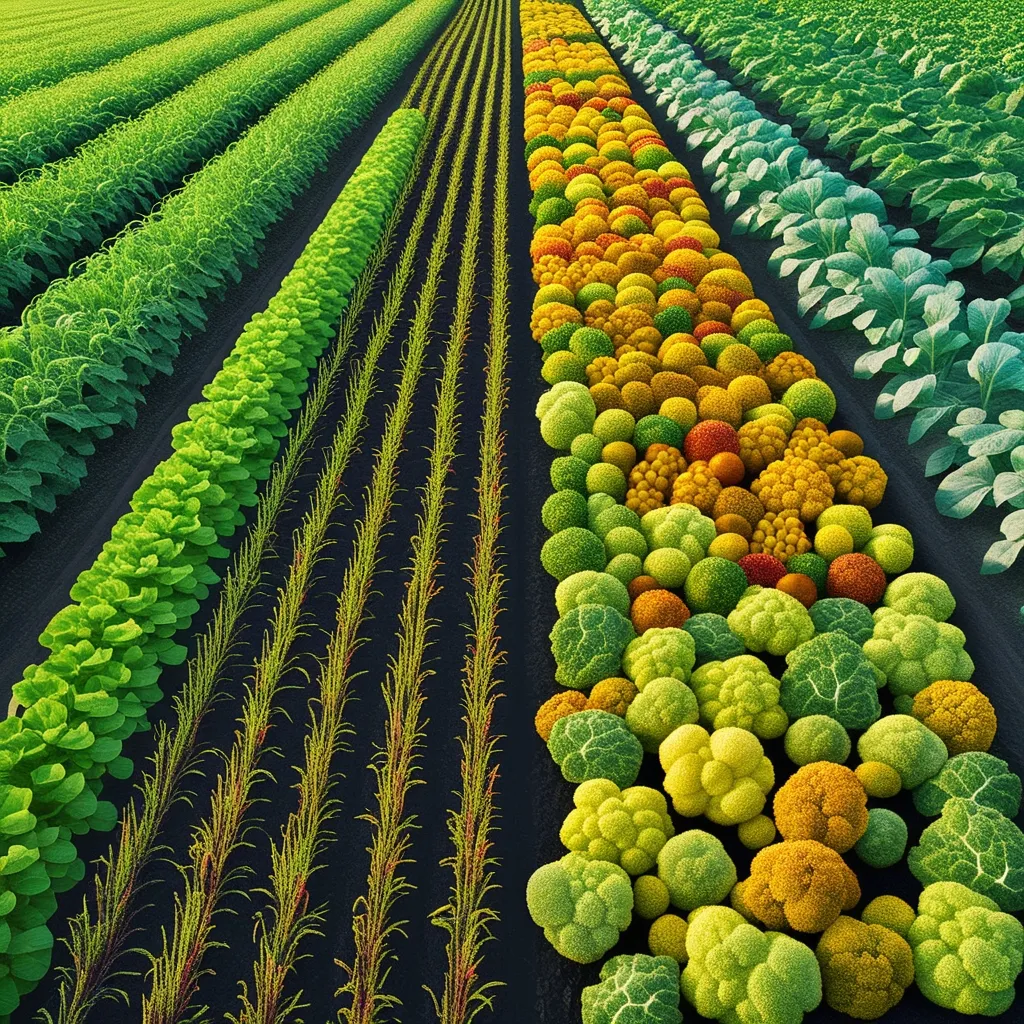Genetically Modified Crops: A Game-Changer for Global Food Security?
In a world grappling with the challenge of feeding an ever-growing population, genetically modified (GM) crops have emerged as a potential solution. But are they really the answer to our food security woes? Let’s dive into this fascinating topic and explore the ins and outs of GM crops.
Picture this: It’s 1996, and farmers in the United States are about to plant the first commercially available GM crops. Fast forward to today, and you’ll find that over 90% of corn, cotton, soybeans, canola, and sugarbeets grown in the U.S. are GM varieties. That’s a pretty impressive adoption rate, don’t you think?
So, what’s the big deal with GM crops anyway? Well, they’re like the superheroes of the plant world. Scientists have figured out how to give them superpowers, like being able to resist pests or tolerate herbicides. It’s like giving plants their own personal bodyguards or protective shields.
Take herbicide-tolerant crops, for example. These bad boys can shrug off weed-killing chemicals like it’s no big deal. Farmers can spray their fields with broad-spectrum herbicides without worrying about damaging their precious crops. It’s a real time-saver and makes weed management a whole lot easier.
Then there are the insect-resistant crops. These clever plants produce their own insecticide, thanks to a gene borrowed from a soil bacterium called Bacillus thuringiensis (Bt). It’s like they’ve got their own built-in pest control system. Pretty neat, huh?
Now, you might be wondering if these GM crops actually make a difference in terms of productivity. Well, the numbers speak for themselves. When pests are a problem, Bt crops tend to outperform their non-Bt counterparts. And let’s not forget about the money farmers save on insecticides. It’s a win-win situation.
But hold on a second. Before we get too carried away singing the praises of GM crops, we need to address the elephant in the room: ecological concerns. Some folks worry about genetic contamination of non-GM crops and wild relatives. Imagine if pollen from a Bt corn plant fertilized a non-Bt crop. That could spell trouble for organic farmers or international trade partners who aren’t keen on GM crops.
There’s also been some buzz about how Bt corn might affect non-target insects, like those beautiful Monarch butterflies. But before you start panicking, it’s worth noting that long-term research hasn’t confirmed these fears yet. Still, it’s something scientists are keeping an eye on.
Now, let’s talk about the big picture. Our planet is expected to have nine billion hungry mouths to feed by 2049. That’s a lot of people, and traditional breeding methods just can’t keep up. They’re like trying to win a race in a horse-drawn carriage when everyone else is driving sports cars.
This is where GM crops really shine. They’re like the Formula 1 cars of the plant world. Scientists can introduce beneficial genes from any source, not just within the same species. It’s like giving plants a genetic upgrade, boosting their yields, nutritional content, and ability to withstand environmental stresses.
Speaking of nutritional content, GM crops aren’t just about quantity; they’re about quality too. Have you heard of “golden rice”? It’s a GM variety enriched with vitamin A and iron, aimed at tackling nutritional deficiencies in developing countries. There are also soybeans with healthier oils and veggies packed with extra vitamin E to help keep our hearts healthy. It’s like nature’s multivitamin, but better.
Of course, not everyone’s on board with the GM train. Different countries have different approaches to regulating these crops. In the U.S., it’s all about the end product. If it’s safe, it’s good to go. But hop across the pond to Europe, and you’ll find much stricter regulations based on the production process itself. It’s like comparing apples and oranges, or in this case, GM apples and non-GM oranges.
Despite these differences, GM crops have been gaining ground globally. By 2009, over 25 countries were growing them. That’s quite a feat considering all the debate surrounding them.
Looking ahead, GM crops are shaping up to be a crucial tool in our quest for sustainable food security. They’re helping to reduce agriculture’s environmental footprint by cutting down on pesticide use and promoting conservation tillage. And with fancy new technologies like CRISPR/Cas9 in the mix, we’re getting even better at tweaking plant genomes to create super-crops that can tough it out in harsh conditions like drought or salty soils.
To put all this into perspective, let’s take a look at GM corn in the U.S. In 2020, a whopping 92% of corn planted was genetically modified. That means when you’re munching on tortilla chips or sipping a soda sweetened with high-fructose corn syrup, chances are you’re consuming GM corn products. It’s become such a big part of our food system that most of us don’t even realize it.
Now, I know what you’re thinking. “This all sounds great, but what about the risks?” It’s a valid concern, and scientists are working hard to address it. They’re constantly conducting research and risk assessments to ensure these crops are safe for us and the environment.
One challenge that’s cropped up (pun intended) is the development of glyphosate-resistant weeds. It’s like the weeds have been hitting the gym and now they’re flexing their muscles against our herbicides. This has led to increased tillage and the use of alternative weed-killers, which kind of defeats the purpose of herbicide-tolerant crops. But don’t worry, clever scientists are already working on new herbicide-resistant traits and integrated pest management strategies to tackle this issue.
So, what’s the verdict on GM crops? Are they the answer to our food security prayers? Well, it’s not quite that simple. They’re a powerful tool, sure, but they’re not a magic wand that will solve all our problems overnight.
GM crops offer improved yields, better nutrition, and increased resistance to pests and environmental stresses. But they also come with valid concerns that need to be addressed through careful regulation, ongoing research, and public education.
Think of GM crops as one piece of a larger puzzle. To truly tackle global food security, we need to combine biotechnology with conventional breeding methods and sustainable farming practices. It’s like creating a super team of agricultural strategies to feed our growing world.
As we move forward, it’s crucial that we keep the conversation going. Scientists, farmers, policymakers, and the public all need to be part of this dialogue. We need to ensure that these technologies are developed and used responsibly, balancing the potential benefits with careful consideration of the risks.
In the end, GM crops represent an exciting frontier in agriculture. They’re not perfect, but they offer tremendous potential to help us meet the nutritional needs of a rapidly growing world population. As we continue to refine and improve these technologies, who knows what incredible developments we might see in the future?
So the next time you bite into an ear of corn or spread some canola oil on your toast, take a moment to appreciate the science and innovation behind your meal. You might just be experiencing the future of food security, one bite at a time.






